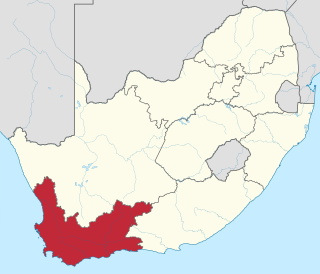
The Western Cape is a province of South Africa, situated on the south-western coast of the country. It is the fourth largest of the nine provinces with an area of 129,449 square kilometres (49,981 sq mi), and the third most populous, with an estimated 7 million inhabitants in 2020. About two-thirds of these inhabitants live in the metropolitan area of Cape Town, which is also the provincial capital. The Western Cape was created in 1994 from part of the former Cape Province. The two largest cities are Cape Town and George.

Tulbaghia is a genus of monocotyledonous herbaceous perennial bulbs native to Africa, belonging to the amaryllis family. It is one of only two known genera in the society garlic tribe within the onion subfamily. The genus was named for Ryk Tulbagh (1699–1771), one time governor of The Cape of Good Hope.

Crocosmia (;), also known as montbretia, is a small genus of flowering plants in the iris family, Iridaceae. It is native to the grasslands of southern and eastern Africa, ranging from South Africa to Sudan. One species is endemic to Madagascar.
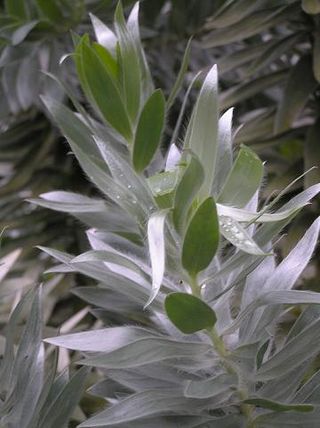
Leucadendron is a genus of about 80 species of flowering plants in the family Proteaceae, endemic to the Cape Provinces and KwaZulu-Natal in South Africa, where they are a prominent part of the fynbos ecoregion and vegetation type.

The Cape Floral Region is a floristic region located near the southern tip of South Africa. It is the only floristic region of the Cape Floristic Kingdom, and includes only one floristic province, known as the Cape Floristic Province.

Bulbinella is a genus of plants in the family Asphodelaceae, subfamily Asphodeloideae, first described as a genus in 1843. Many species are endemic to Cape Province in western South Africa, confined to the winter rainfall area. Other species are endemic to New Zealand, where they are most common in the central Otago region which enjoys a similar climate to the Cape Region of South Africa.
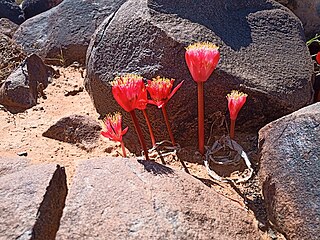
Haemanthus barkerae is a South African bulbous geophyte in the genus Haemanthus. H. barkerae is found in the Western Cape from the Bokkeveld Mountains near Nieuwoudtville and the foothills of the Roggeveld Mountains, to the Hantamsberg near Calvinia, and bounded to the north and south by Loeriesfontein and the Tanqua Karoo.

Strumaria is a genus of African plants in Amaryllis family, subfamily Amaryllidoideae. The genus is known in nature only from South Africa, Lesotho and Namibia. Almost all species flower in the autumn and are cultivated as ornamental bulbous plants.

Trachyandra is a genus of plant in the family Asphodelaceae, subfamily Asphodeloideae, first described as a genus in 1843. It is native to eastern and southern Africa, as well as to Yemen and Madagascar. Many of the species are endemic to South Africa.
- Trachyandra acocksiiOberm. - Cape Province in South Africa
- Trachyandra adamsonii(Compton) Oberm. - Cape Province, Namibia
- Trachyandra affinisKunth - Cape Province, KwaZulu-Natal
- Trachyandra arenicolaJ.C.Manning & Goldblatt - Cape Province
- Trachyandra aridimontanaJ.C.Manning - Cape Province
- Trachyandra arvensis(Schinz) Oberm. - Angola, Zambia, Zimbabwe, Botswana, Namibia
- Trachyandra asperataKunth - South Africa, Lesotho, Eswatini
- Trachyandra brachypoda(Baker) Oberm. - Cape Province
- Trachyandra bulbinifolia(Dinter) Oberm. - Cape Province, Namibia
- Trachyandra burkei(Baker) Oberm. - Botswana, Limpopo, Free State, Cape Province
- Trachyandra capillata(Poelln.) Oberm. - KwaZulu-Natal
- Trachyandra chlamydophylla(Baker) Oberm. - Cape Province
- Trachyandra ciliata(L.f.) Kunth - Cape Province, Namibia
- Trachyandra dissectaOberm. - Cape Province
- Trachyandra divaricata(Jacq.) Kunth - Cape Province; naturalized in Australia
- Trachyandra ensifolia (Sölch) Roessler - Namibia
- Trachyandra erythrorrhiza(Conrath) Oberm. - Gauteng
- Trachyandra esterhuysenaeOberm. - Cape Province
- Trachyandra falcata(L.f.) Kunth - Cape Province, Namibia
- Trachyandra filiformis(Aiton) Oberm. - Cape Province
- Trachyandra flexifolia(L.f.) Kunth - Cape Province
- Trachyandra gerrardii(Baker) Oberm. - Eswatini, South Africa
- Trachyandra giffenii(F.M.Leight.) Oberm. - Cape Province
- Trachyandra glandulosa(Dinter) Oberm. - Namibia
- Trachyandra gracilentaOberm. - Cape Province
- Trachyandra hantamensisBoatwr. & J.C.Manning - Cape Province
- Trachyandra hirsuta(Thunb.) Kunth - Cape Province
- Trachyandra hirsutiflora(Adamson) Oberm. - Cape Province
- Trachyandra hispida(L.) Kunth - Cape Province
- Trachyandra involucrata(Baker) Oberm. - Cape Province
- Trachyandra jacquiniana(Schult. & Schult.f.) Oberm. - Cape Province
- Trachyandra kamiesbergensisBoatwr. & J.C.Manning - Cape Province
- Trachyandra karrooicaOberm. - Cape Province, Namibia
- Trachyandra lanata(Dinter) Oberm. - Namibia
- Trachyandra laxa(N.E.Br.) Oberm. - South Africa, Namibia, Botswana
- Trachyandra malosana(Baker) Oberm. - Malawi to Zimbabwe
- Trachyandra mandrarensis(H.Perrier) Marais & Reilly - Madagascar
- Trachyandra margaretaeOberm. - Mpumalanga, KwaZulu-Natal
- Trachyandra montanaJ.C.Manning & Goldblatt - Cape Province
- Trachyandra muricata(L.f.) Kunth - Cape Province, Namibia
- Trachyandra oligotricha(Baker) Oberm. - Cape Province
- Trachyandra paniculataOberm. - Cape Province
- Trachyandra patensOberm. - Cape Province
- Trachyandra peculiaris(Dinter) Oberm. - Namibia
- Trachyandra proliferaP.L.Perry - Cape Province
- Trachyandra pyrenicarpa(Welw. ex Baker) Oberm. Huíla Province in Angola
- Trachyandra revoluta(L.) Kunth - Cape Province, Namibia
- Trachyandra sabulosa(Adamson) Oberm. - Cape Province
- Trachyandra saltii(Baker) Oberm. - eastern + southern Africa from Ethiopia to Cape Province; Yemen
- Trachyandra sanguinorhizaBoatwr. & J.C.Manning - Cape Province
- Trachyandra scabra(L.f.) Kunth - Cape Province
- Trachyandra smallianaHilliard & B.L.Burtt - Cape Province, KwaZulu-Natal
- Trachyandra tabularis(Baker) Oberm. - Cape Province
- Trachyandra thyrsoidea(Baker) Oberm. - Cape Province
- Trachyandra tortilis(Baker) Oberm. - Cape Province
- Trachyandra triquetraThulin - Somalia
- Trachyandra zebrina(Schltr. ex Poelln.) Oberm. - Cape Province

Romulea is a genus of flowering plants in the family Iridaceae, first described as a genus in 1772. It is found in Europe, the Mediterranean, the Arabian Peninsula, and Africa.

Albuca is a genus of flowering plants in the family Asparagaceae, subfamily Scilloideae. The genus is distributed mainly in southern and eastern Africa, with some species occurring in northern Africa and the Arabian Peninsula. Plants of the genus are known commonly as slime lilies.

Drimia is a genus of African, south European and south Asian flowering plants. In the APG IV classification system, it is placed in the family Asparagaceae, subfamily Scilloideae. When broadly circumscribed, the genus includes a number of other genera previously treated separately, including Litanthus, Rhodocodon, Schizobasis and Urginea.

Bulbinella elegans is a species of plant in the family Asphodelaceae. It is found in the Cape Province of South Africa.
Winsome Fanny Barker was a South African botanist and plant collector noted for her work as Curator building the collection at the herbarium of the Kirstenbosch National Botanical Garden, as well as her research on Amaryllidaceae, Liliaceae and Haemodoraceae.
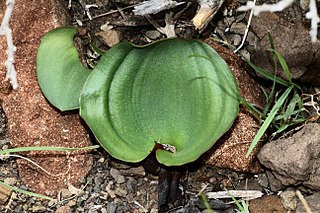
Eriospermum capense is a species of geophytic plant of the genus Eriospermum, indigenous to the Western Cape Province, South Africa.

Bulbinella nutans is a species of plants in the family Asphodelaceae. It is found in the Cape Province of South Africa.
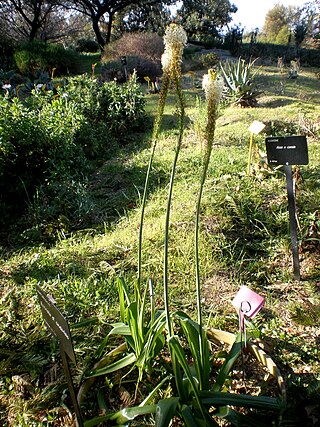
Bulbinella cauda-felis is a species of plant in the family Asphodelaceae. It is widespread in the Cape Province of South Africa. This species favours drier regions, in renosterveld and karoo vegetation, where it grows in shale or clay soils.
Pauline Lesley Perry is a South African botanist, horticulturalist and plant collector.

Leucadendron barkerae, the Swartberg conebush, is a flower-bearing shrub that belongs to the genus Leucadendron and forms part of the fynbos. The plant is native to the Western Cape, South Africa.
















